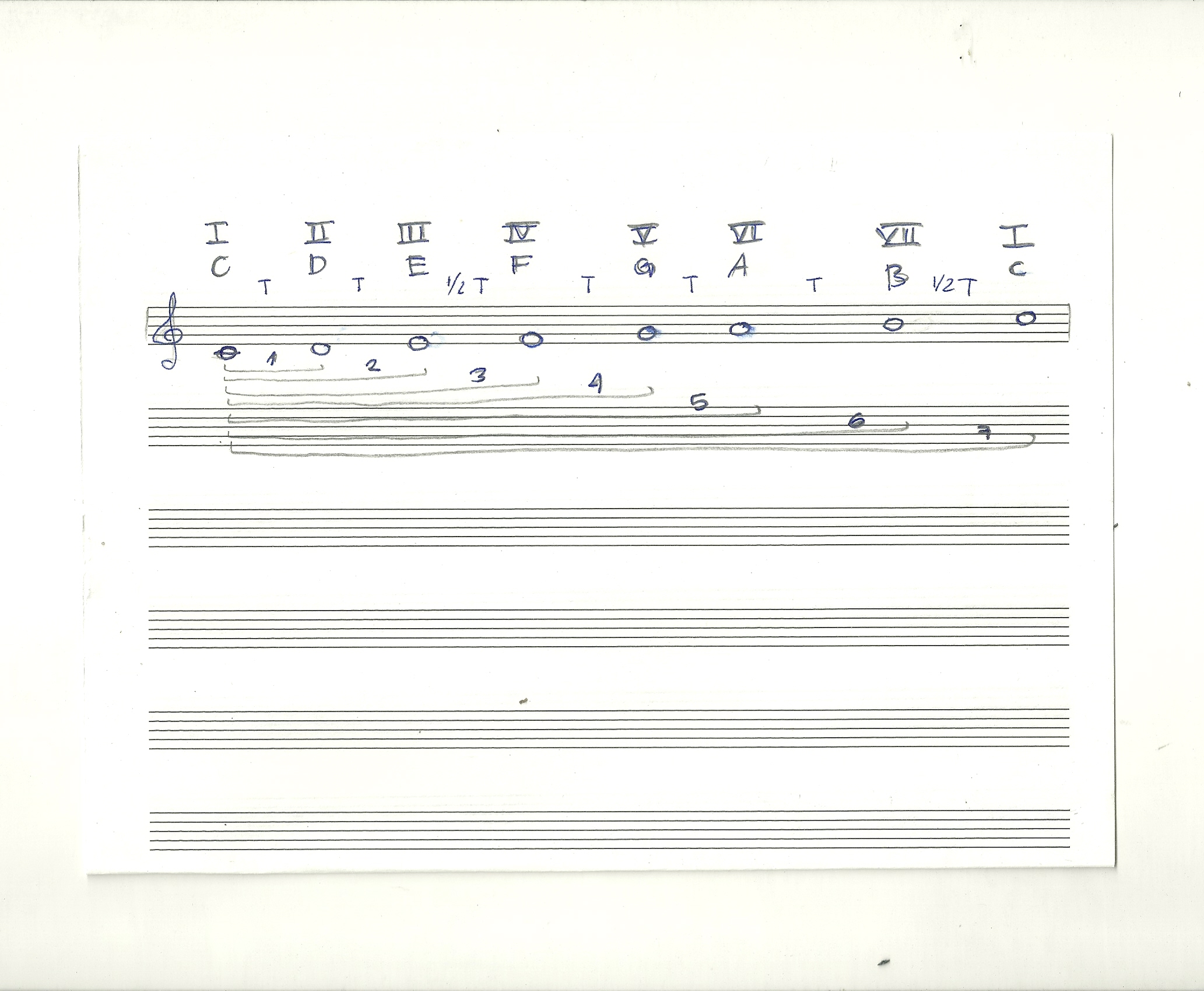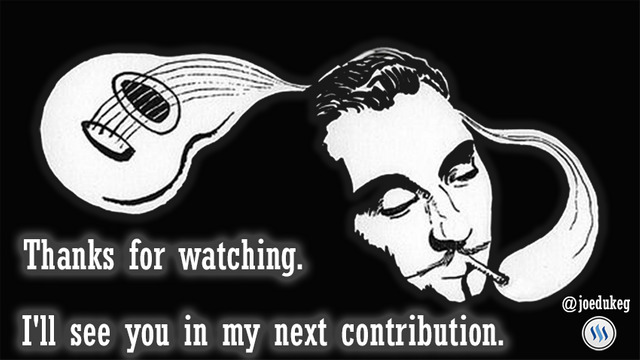Welcome to a new Music Education Article.
This is an epic lesson, so prepare yourself.
This time I will teach you about the Modes and how to play the Ionian Mode on the guitar.
- Guitar Lessons - Major Scale or Ionian Mode - How to play all patterns in the instrument?
- Guitar Lessons - How I gain freedom on the instrument? - Connecting patterns (Major Scale)
The lesson below contains a different meaning than the previous ones, the following patterns have different applications, this lesson will be more specific to the Ionian Mode in theory and in practice.
What is a mode?
It as a scale which is contained within the structure of the Diatonic or Major Scale, each of these modes, despite being constituted by the same notes of the Major Scale, will produce a different sensation to the ear, for example:
- The C Major Scale contains the following notes: C, D, E, F, G, A, B, C.
Graphic example of Ionian Mode (Major scale):

- Starting on the second note of the scale of C major (applies to all major scales), we obtain the Dorian Mode: D, E , F, G, A, B, C, D.
Graphic example of Dorian Mode

The red note is the Root or Tonic of the Scale
The notes of all the modes that co exist in the Major Scale are the same, what changes is the ambit in which they are reproduced, starting from the root (the first note) to the octave (repetition of the note in a more high register) and the intervals that separate these sounds which change from one mode to another.
In the first case (first graphic example) the notes ascend from C to C, with the structure of the major scale:
- Ionian Mode: T - T - HT - T - T - T - HT or also T - T - 1/2 T - T - T - T - 1/2 T.
T = Tone -
HT or 1/2 T = Half Tone
In the second case (second graphic example), the notes ascend from D to D, they are the same notes as the major C Major Scale, but reproduced in a different order, therefore, with a different interval structure, which produces a different sonority. And the structure would be the following:
- Dorian Mode: T - HT - T - T - T - HT - T
So, if the Major Scale has 7 notes, it means that there are 7 modes in that scale, one mode for each note, how I had specified in the previous lesson, these are each of the modes contained in the Major Scale:
- Starting on the Tonic or Root (Symbol R): Ionian Mode (The Major Scale)
- Starting on the Major Second; second note of the major scale (Symbol 2 or 2 △): Dorian Mode
- Starting on the Major Third ; third note of the major scale (Symbol 3 or 3 △): Frigian Mode
- Starting on the Perfect Fourth; fourth note of the major scale (Symbol p4 or 4): Lidian Mode
- Starting on the Perfect Fifth; fifth note of the major scale (Symbol p5 or 5): Mixolidian mode
- Starting on the Major Sixth; sixth note of the major scale (Symbol 6 or 6 △): Eolian Mode or Natural Minor Scale
- Starting on the Major Seventh; seventh note of the major scale (Symbol 7 or 7 △): Locrian Mode
- Of these 7 modes, 3 are considered as Major Scales because they contain a Major Third in their structure: Ionian, Lidian and Mixolidian.
- And 4 are considered minor because they contain a minor third: Dorian, Frigian, Eolian and Locrian.
Modes are not exclusive to the Major Scale, they are also present in the Melodic Minor Scale, the Harmonic Minor Scale and the Harmonic Major Scale. This is more advanced material, we can review it in future lessons.
The Ionian mode is the "first mode", it is Major Scale in itself, and corresponds to the first note of the Major Scale, which gives the name to the scale. For example: If we are in G Major, the ionian mode start on the first note of that scale, then it is the G Ionian Scale.
It is an important piece for the construction of an entire system through which we understand and analyze harmony and melody in music.
Sonority:
Listening to the Ionian Mode, in most cases, transmits emotions, feelings, thoughts or simply sensations associated with confort and happiness.
A remarkable feature of this mode, is that if we analyze their intervals respect to the Root or Tonic, we have that all of them are Major and Perfect intervals, this undoubtedly gives us indications of why it causes us so much comfort to the ear.
Examples of their sound:
These are songs in which we can determine that the Ionian mode or a Major Scale is the tonal center.
"Happy Birthday"
"Alborada" Francisco Tárrega
Structure and analysis:
I, II, III, IV, V, VI and VII represent each of the Major Scale degrees.
These degrees are separated in this way: Tone, Half tone, Tone , Tone, Tone, Tone and Half tone.

Starting from the Tonic, taking as an example C Major, each number represents the intervalic analysis between the two notes that constitute the interval, the number represents the distance in tones and semitones between the two sounds.
According to the analysis:
- From C to D there is a distance or interval of a major cecond, one Tone (T), this distance is represented by a 2.
- From C to E there is a distance or interval of a major third, two tones (2 T), this distance is represented by a 3, 3 △ or 3M.
- From C to F there is a distance or interval of perfect fourth, two tones and a halftone (2 T + 1/2 T), this distance is represented by a 4.
- From C to G there is a distance or interval of perfect fourth, three tones and a halfitone (3 T + 1/2 T), this distance is represented by a 5.
- From C to A there is a distance or interval of the major sixth, four tones and a halftone (4 T + 1/2 T), this distance is represented by a 6, 6 △ or 6M.
- From C to B there is a distance or interval of major seventh, five tones and a halftone (5 T + 1/2 T), this distance is represented by a 7, 7 △ or 7M.
- From C to C there is a distance or interval of an octave, five tones and two halftones (5 T + 2 ST), this distance is represented by a 8.
On the guitar a Halftone is a fret and a Tone are two frets.
All patterns fingering, example in C Ionian.
Patterns
Each of the following patterns contains the notes corresponding to the Ionian mode in different keys, and their fingerings on the guitar fingerboard.
Click on the mouse below to open the image in original size.
The patterns with numbers are the ones that contain the Fingering
First pattern

Recommendations:
1 - These patterns can be transported to any area of the guitar fretboard, in order to locate us in the tonalities or modes that we want.
2 - Before playing them, try to visualize them in the fingerboard, close your eyes and imagine which region you are going to play, fingering, etc. Afterwards, open your eyes and see where you want to touch it. Now that you have it mentally, touch them at a slow speed, preventing any type of error, in this way you will memorize the correct technique and fingering.
3 - Play them safely, despite being a technical exercise is recommended to play them with the same grace with which we would play a song that we like, that each note sounds good.
4 - Do not forget to improvise! Experiment with the various combinations of sounds offered by the major scale, play with them and compose melodies that you like, always give a creative touch to everything you practice.
Help me to help you:
If you would like me to do some lessons or tutorials about music and guitar, if you want to make any suggestions regarding my post, constructive criticism, how could I improve, etc. I invite you to let me know in the comments box.

Source
- This content is totally original, created by me based on my studies as a guitarist and my musical experience.
- I have made the patterns with an excellent software: Neck Diagrams

Design: @Cre47iv3






